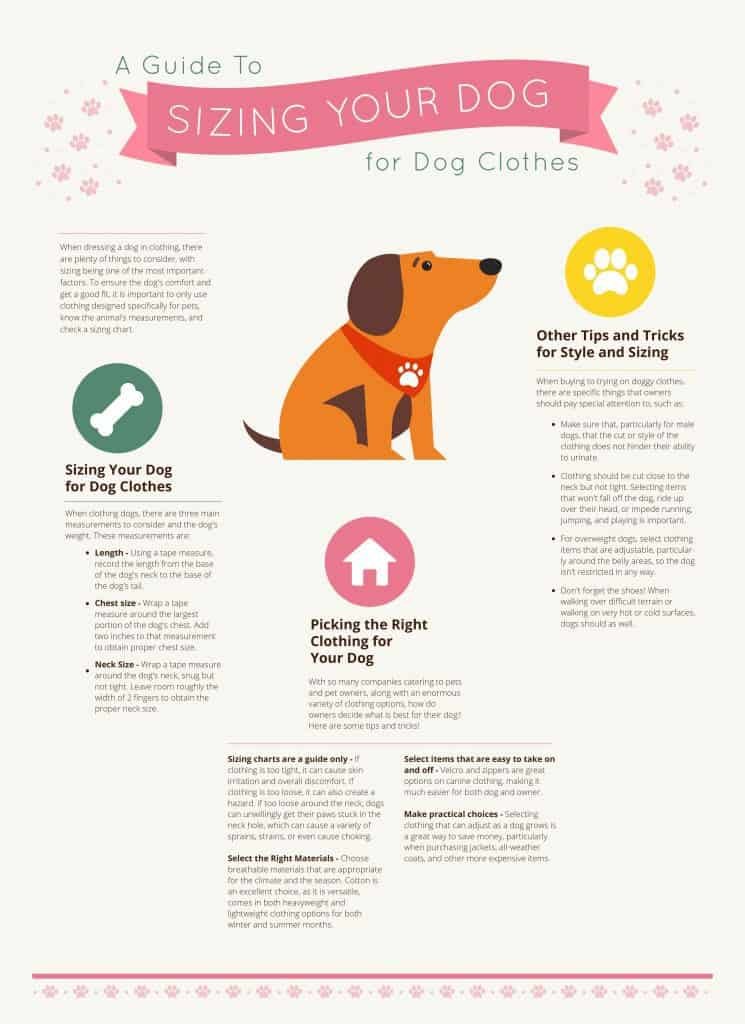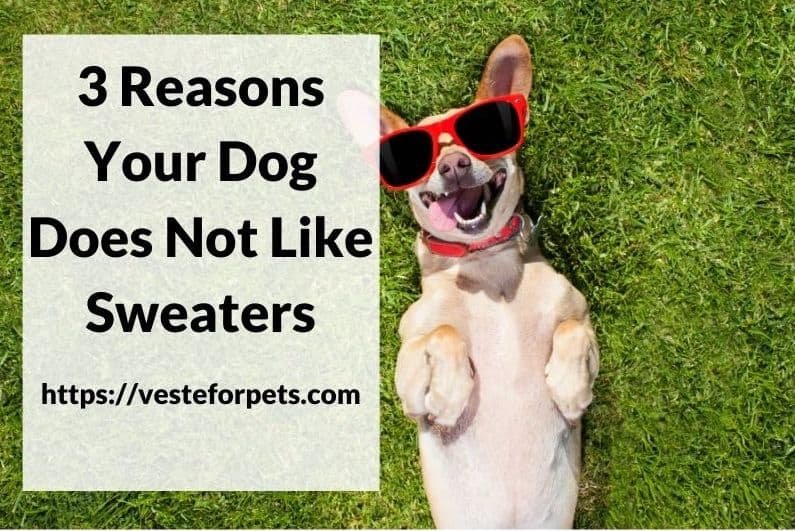The Pet Industry is big business. An independent report estimated that in the year 2020 alone, pet owners in the United States spent $99 billion on their furry and feathered friends, including food, toys, grooming, and clothing. Clothing items for pets, dogs, in particular, continue to increase in popularity, with 40% of dog owners admitting to owning at least one article of clothing for their pooch. 10% of dog owners report that they regularly dress their pup in clothing specially designed for dogs.
When dressing a dog in clothing, there are plenty of things to consider, with sizing being one of the most important factors. To ensure the dog’s comfort and get a good fit, it is important to only use clothing designed specifically for pets, know the animal’s measurements, and checka sizing chart.
If a dog is dressed in clothing that is not the proper fit, it can cause discomfort, anxiety, and skin irritation. Seriously ill-fitting clothing can even interfere with circulation, or if too tight around the neck, it can inhibit breathing. Therefore, follow this general guide to ensure the safety of the animal.

A Guide to Sizing Your Dog for Dog Clothes
The most important part about sizing is ensuring proper measurements. When clothing dogs, there are threemain measurements to consider and the dog’s weight. These measurements are:
- Length – Using a tape measure, record the length from the base of the dog’s neck to the base of the dog’s tail.
- Chest size – Wrap a tape measure around the largest portion of the dog’s chest. Add twoinches to that measurement to obtain proper chest size.
- Neck Size – Wrap a tape measure around the dog’s neck, snug but not tight. Leave room roughly the width of 2 fingers to obtain the proper neck size.
In addition to recording accurate measurements, a dog’s weight is equally important. Dogs who are overweight may need to be sized up, regardless of the animal’s official length, chest, and neck measurements.
Basic Size Chart
Below is a basic size chart for dogs. Keep in mind, there is some overlap in sizing, and when determining the appropriate size for a particular dog, all threemeasurements, along with weight, must be considered.
| Sizing Chart for Dogs | |||
| Length (in inches) | Neck (in inches) | Chest (in inches) | |
| 2XS | 5 – 7.5 in | 5.5 -7.5 in | 8.5 – 10.5 in |
| XS | 7.5 – 10 in | 7.5 – 9.5 in | 10.5 – 13 in |
| S | 9.5 – 12 in | 9 – 11 in | 12.5 -16 in |
| M | 11.5 – 14 in | 10.5 – 12.5 in | 15.5 – 18 in |
| L | 13.5 – 16.5 in | 12 – 14 in | 17.5 – 20.5 in |
| XL | 15.5 -18.5 in | 13.5 – 15.5 in | 20 – 23 in |
| 2XL | 17.5 -21 in | 15 – 17.5 in | 22 – 25.5 in |
| 3XL | 21 -24 in | 16.5 – 20 in | 24.5 – 29.5 in |
| 4XL | 24.5 – 28.5 in | 19 – 22 in | 28.5 – 33 in |
Like human sizing, there can be differences in accurate sizing based on clothing brands or manufacturers, so the above listed sizes are only estimated. If a particular clothing brand runs smaller or larger, adjust the sizing selection accordingly.
How is Sizing Affected by Weight?
When sizing clothing for dogs, measurements are done to determine length, chest, and neck size. Unfortunately, none of these measurements specifically take a dog’s weight into consideration. The basic sizing chart is designed for dogs that are at a proper weight. For dogs that may be slightly overweight, owners may need to size up accordingly.
For morbidly obese animals,dogs that are well above their suggested weight range, clothing simply may not be an option unless it’s custom made. Here is a basic size chart that helps to estimate a healthy weight for dogs based on breed size.
| Estimated Weight Chart – Adult Dogs | ||
| Size | Weight | Breed Examples |
| Extra Small | 1 – 10 pounds | Yorkies, Chihuahuas, Pomeranians, Maltese, Papillons |
| Small | 11 – 25 pounds | Shih Tzu, Pugs, Dachshunds, Boston Terrier, Mini Pinschers, Bichon Frises, West Highland Terriers |
| Medium | 26 – 40 pounds | Beagle, Mini Schnauzers, Shetland Sheepdogs, Cavalier King Charles Spaniel, Scottish Terriers |
| Large | 41 – 70 pounds | Boxers, Bulldogs, Cocker Spaniels Basset Hounds, Bull Terriers, Shar Peis |
| Extra Large | 71 – 90 pounds | Labrador Retrievers, German Shepards, Rottweilers, Doberman Pinschers, Siberian Huskies, Chow-Chow, Standard Poodles, Border Collies |
| Extra-Extra-Large | 91 – 110 pounds | Alaskan Malamute, Bernese Mountain Dog, Great Danes, St. Bernards, Old English Sheepdogs, Newfoundlands |
Clothing Debate-Dogs Wearing Sweaters, Yes or No?
As various social media platforms continue to grow in popularity, more and more dog owners are dressing up their pups for a family fun photoshoot. However, under any adorable picture of a Beagle in a Christmas sweater, there will be at least one person debating the merits of dogs wearing clothes. Dog owners, who are often passionate about their pets, will debate the clothing issue at length, with each side feeling secure in their position.
So, who is right? Is it OK to dress a dog in clothing, or are owners unknowingly causing harm to their pets? Is it downright wrong to put clothing on a dog, or is it a bit of harmless fun? While it seems like a small argument, pet accessories are big business, with owners spending over $15 million a year on clothing for their dogs.
Veterinarians Weigh in on the Debate
Seeking wisdom on the topic, we turned toward professionals to see what veterinarians had to say about pets, and more specifically dogs, wearing clothing. Is it OK or detrimental to the dog’s health or development? The answer is – It depends!
There are several factors to consider when determining whether clothing is safe for a pup, such as:
- Climate or Season
- Breed and Size
- Age
- Grooming Habits
- Temperament
- Special Occasion
Climate or Season
For dogs in cooler climates, especially during the colder winter months, clothing such as a sweater, or even shoes, are a welcome change of pace for the animal. Just like humans, dogs are affected by the weather and can get increasingly uncomfortable outside as the temperatures drop. If a dog seems hesitant to go outside, is openly shivering in the cold, or side-stepping to avoid keeping its paws down on the ground for too long, it is most likely uncomfortable in the cold weather.
In cases like this, slipping on a sweater and some winter dog boots may make the pup much more comfortable and increasingly more willing to complete their afternoon or evening winter walk. For all dog breeds, exercise is critical to maintaining good health and managing proper weight, so in these circumstances, clothing is completely appropriate.
Breed and Size

Depending on the breed and size of a dog, clothing may or may not be appropriate. Dog breeds that originated in colder climates, such as Alaskan Malamutes, Newfoundlands, Siberian Huskies, St. Bernards, and American Eskimo dogs, will do just fine outside in the winter without any extra clothing. In fact, for these breeds and other cold climate pups, extra clothing will actually cause discomfort and potentially lead to overheating.
On the other side of the spectrum, smaller dog breeds and those that sit low to the ground, such as Chihuahuas or Corgis, often can not hold their body heat, and larger breeds. As such, even in more temperate weather, smaller dogs can quickly get chilly, as evidenced by shivering, shaking, and a hunched posture or unwillingness to go outside. In this circumstance, clothing, such as a nice, cozy warm sweater, is ideal for the dog.
Age
As dogs get older, they may struggle to maintain body temperature. It is much more difficult for senior dogs to regulate their temperature, and as such, they get cold and uncomfortable more often. If owners notice signs that their senior dog is chilly, it is perfectly fine to bundle up the pooch by dressing him up in a comfortable sweater and adding a blanket to his doggy bed.
Grooming Patterns
Several dog breeds naturally have long fur but are regularly groomed by owners. Commonly groomed breeds include English Sheepdogs and Poodles. Their naturally long fur helps to protect these dogs from colder weather. While regular grooming and shearing may be encouraged, the loss of their natural coat may make these breeds more susceptible to cold weather or a drop in the temperature.
For these breeds, clothing, particularly right after a session at the groomers, is ideal. The extra layer of clothing will keep the dog comfortable, particularly when outside or in colder weather. Even inside, during the first week or so after grooming, the dog may appreciate the extra layer of protection that pet clothing offers.
Temperament
Temperature control is not the only reason why a vet, or other animal expert, would recommend clothing for a dog. Believe it or not, temperament can also play a role in determining whether clothing is appropriate for a pup. For nervous or anxious dogs or dogs that have been diagnosed with separation anxiety, clothing can actually help ease some of the anxious symptoms.
Specially designed anxiety vests or anxiety shirts are often recommended for dogs that suffer from anxious conditions. Experts who design these animal garments describe the vests as providing the same type of comfort that newborns receive when being swaddled.
For some canines, the vests/shirts are only necessary during times of particularly high anxiety, while for others, wearing the garment all day is preferred. Owners who feel their dog may be suffering from anxiety or other mood disorder should contact their veterinarian for specific advice regarding anxiety vests or shirts.
Special Occasions
Even the most conservative animal experts agree that once in a while, dressing up a pet is perfectly acceptable unless the animal displays clear signs of discomfort, fear, or anxiety when placed in clothing.
So for owners looking to snap a special picture or wish to dress their dog for Halloween or Christmas, most experts agree that this practice is perfectly fine!
Picking the Right Clothing for Your Dog

So, once an owner has decided that dressing up their dog is appropriate, it’s time to select a doggy wardrobe! With so many companies catering to pets and pet owners,along with an enormous variety of clothing options, how do owners decide what is best for their dog? Here are some tips and tricks!
- Sizing charts are a guide only – It is important to make sure any clothing selected for a dog fits comfortably. It should not be too tight or too loose. If clothing is too tight, it can cause skin irritation and overall discomfort. If clothing is too loose, it can also create a hazard. If too loose around the neck, dogs can unwillingly get their paws stuck in the neck hole, which can cause a variety of sprains, strains, or even cause choking.
Therefore, while it is important to check sizing guidelines, owners should pay close attention to how each article of clothing fits their individual dog. There simply may be certain brands of clothing or specific styles and cuts that fit better. Whenever possible, owners should try the clothing on the pup before purchase, or if buying online, make sure that the company has a fair return policy.
- Select the Right Materials – Comfort is important to anyone when buying clothing, and this also extends to buying clothes for pets. Choose breathable materials that are appropriate for the climate and the season. Cotton is an excellent choice, as it is versatile, comes in both heavyweight and lightweight clothing options for both winter and summer months.
Picking clothing suitable for weather conditions is also important. Having a nice hoodie for walks in the rain or snow is ideal for keeping the doggy’s ears warm and dry. Lightweight t-shirts will keep flies and mosquitoes from biting the dog during the summer months. Practical clothing choices can be a big plus for both animal and owner.
- Select items that are easy to take on and off– Velcro and zippers are great options on canine clothing, making it much easier for both dog and owner. Having clothing options that are easy to slip on and off and adjust, make the process of dressing and undressing a dog much easier and less cumbersome.
Watch out for clothing that has adornments, such as ribbons or bows, and other accessories. While it can be tempting to select a cute, sparkly outfit, these extra accessories can truly be a choking hazard for the dog. Instead, look for pretty patterns and bright colors that pose no additional choking hazard for the pup.
- Make practical choices – Selecting clothing that can adjust as a dog grows is a great way to save money, particularly when purchasing jackets, all-weather coats, and other more expensive items. Also, for owners walking their pooch at night, consider buying brightly colored, white, or reflective clothing to help keep both dog and owner safe when walking in the dark.
Other Tips and Tricks for Style and Sizing
When buying to trying on doggy clothes, there are specific things that owners should pay special attention to, such as:
- Make sure that, particularly for male dogs, that the cut or style of the clothing does not hinder their ability to urinate.
- Clothing should be cut close to the neck but not tight. Selecting items that won’t fall off the dog, ride up over their head, or impede running, jumping, and playing is important. Think of this in terms of the Goldilocks principle – not too big, not too small. There should be some room around the neck to avoid choking, but not so much room that the dog can slip his head out of the garment.
- For overweight dogs, select clothing items that are adjustable, particularly around the belly areas, so the dog isn’t restricted in any way.
- Don’t forget the shoes! Humans aren’t the only creatures who should be wearing shoes! When walking over difficult terrain or walking on very hot or cold surfaces, dogs should as well. Hot asphalt, snow, and ice, as well as rocky paths, can all be hard on a dog’s feet, and doggie shoes are a great way to protect the dog’s feet.
As the Pet industry continues to grow, particularly in the United States, there are more and more clothing options for household pets. For owners who dress their dog daily when facing the harsh winter weather, those who enjoy selecting cutesy, stylized clothing options for a fun photoshoot, or owners simply dressing up their doggy for a special occasion, it is important to make sure the clothing:
- Fits properly
- It is made of breathable, comfortable material
- Poses no physical risk or emotional stress for the animal
For owners who are still unsure whether or not clothing is appropriate for their pup, take a moment to speak to a veterinarian or other animal expert, who can help decide if dressing your dog is the appropriate choice for both of you.
Content Disclaimer
The information contained above is provided for information purposes only. The contents of this Blog article are not intended to amount to advice, and you should not rely on any of the contents of this Blog article. Professional advice should be obtained before taking or refraining from taking any action as a result of the contents of this Blog article. VesteForPets.com disclaims all liability and responsibility arising from any reliance placed on any of the contents of this Blog article.
Copyright Notice
These works are protected by copyright laws and treaties around the world. We grant to you a worldwide, non-exclusive, royalty-free, revocable licence to view these works, to copy and store these works and to print pages of these works for your own personal and non-commercial use. You may not reproduce in any format any part of the works without our prior written consent.
Copyright © 2022 – 2024 Veste For Pets







